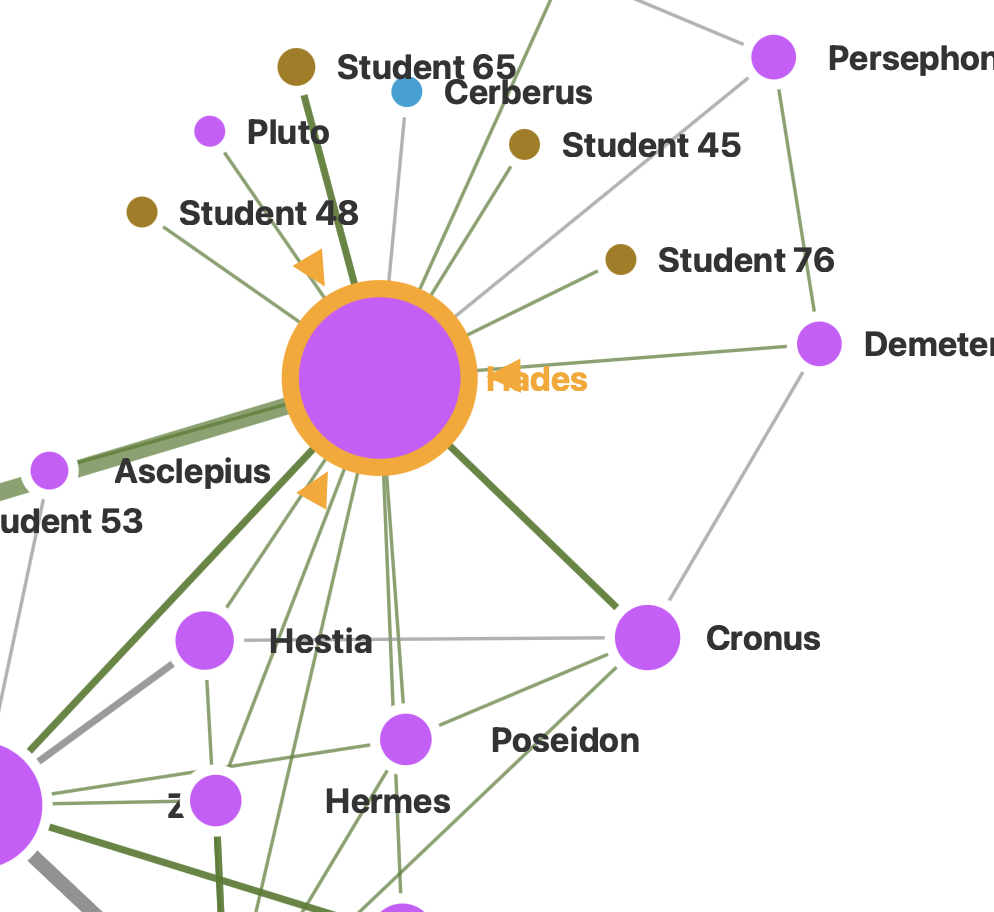
Should I choose this template?
Do you have a complex primary or secondary source with lots of elements–people, places, things, events–that students struggle to keep track of? This network lets students track the many kinds of connections that are possible in complex historical sources. This network facilitates students to:
- make connections between elements within a source or topic
- make connections between elements of a source or topic and themselves
- make connections with their peers
Teachers who have used this type of network have created purposeful environments where students were able to see how they are engaged by sharing about themselves and connecting to their learning and peers.
When should I use this template?
When you have a lesson with a barrage of names, dates, and places, and you want students to find one or two connections that will help them better engage with the readign.
What sources work best?
- Primary sources or secondary sources that have a lot of historical detail and a lot of interaction
What’s the investment in time and effort for this network?
Time: From one class period to many. This activity is especially helpful for integrating several different readings. Used across several sources, the network can help remind students of previous historical events or figures they encountered months or weeks ago.
Teacher support: Teachers will need to
- understand the basics of Net.Create (node and edge entry). See this basic-data-entry video!
- how to toggle between network view and table view and sort columns in table view.
- how to use one network filter (the “?????” filter). See this ?????-filter video!
How should I use this template?
Network Details: What should my students and I be tracking?
For any network, students will track nodes (things) and edges (relationships between things), each of which will also have “attributes” (which include mandatory info like citations and optional info like extra notes).
Nodes (things being connected)
In this network, the nodes represent people, places, objects, groups, and activities that are part of the text or source students are reading and/or are important to the students in the class.
- Person: A person from the text or a student in the class. For example, when studying a source about Greek mythology, a person node might be Zeus (the Greek god) or Adam (a student in the class).
- Activity: Something that a person or group of people do. For example, when studying a source about Greek mythology, an activity node might be “a heroic quest”.
- Object: A physical thing. For example, when studying a source about Greek mythology, an object node might be “lightning bolt”.
- Group: A group of people. For example, when studying a source about Greek mythology, a group node might be “demigods”.
- Place: A location or significant place. For example, when studying a source about Greek mythology, a place node might be “the underworld”.
Edges (connection types)
In this network, the edges show things that are connected. Since the network has both elements of the text or source and elements of real life, nodes from the two should be connected showing relationships between the text or source and the students.
-*interacts with: You would use “interacts with” to connect two nodes that have some sort of interaction and an explanation of the interaction. This will likely be a connection between two nodes from the text or source. For example, when studying a source about Greek mythology, there might be an edge showing “Zeus” - “interacts with” - “Hera” with a note saying “Hera is Zeus’s wife”.
- Connected to: You would use “connected to” to connect two nodes that are related and an explanation of the connection. For example, there might be an edge showing “Hades” - “connected to” - “underworld” and an edge showing “Adam” (a student in the class) - “connected to” - “Apollo” with a note saying “I like music”.
What learning goals does this template support?
- D2.His.5.6-8: Explain how and why perspectives of people have changed over time.
- D2.His.10.6-8: Detect possible limitations in the historical record based on evidence collected from different kinds of historical sources.
What data literacy outcomes does this template support?
- Students will learn that data itself can change over time. While we sometimes consider data “static” in that it will not change, we often change the data itself in use, or through interpretation, or because it describes things that are constantly changing, such as historical norms.
- Students will learn that data can be messy, and some data is inconsistent and / or has missing information, which is common in the real world
- Students will learn to integrate individual data points and aggregate data patterns. Individual data points may inform certain questions, while patterns within and across datasets help answer others.
Resources for classroom use
Teacher Resources
- Classroom management recommendations
- Network-analysis learning Resources
- Simple Net.Create documentation
- Videos of new node/edge, table sorting, filters, etc.
- 5-moves-to-make video
- 1-pager lesson plan
- “Good questions to ask” guide for teachers
- What network-data moves (viz, tables, filters) to use as network gets big Example lesson plan - Greek Myths
Student Handouts
- “Good questions to ask” guide for teachers

More about this item
Dublin Core
